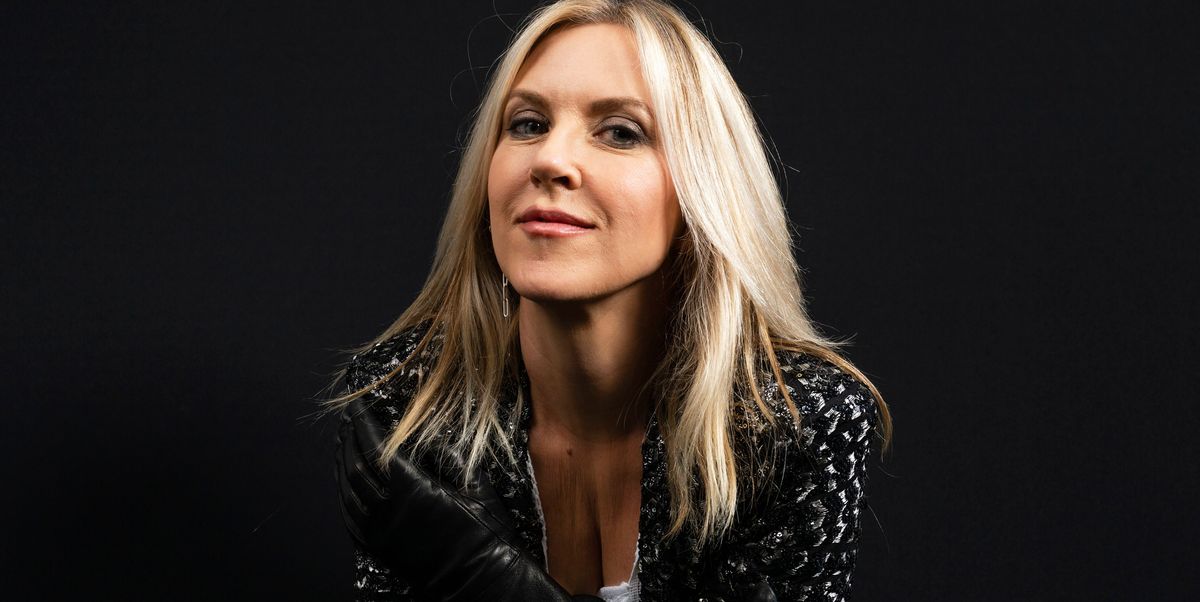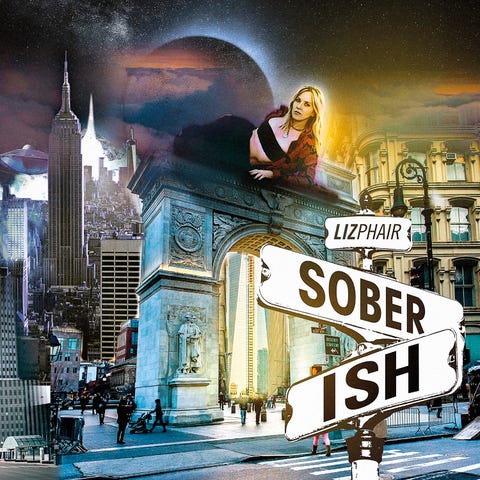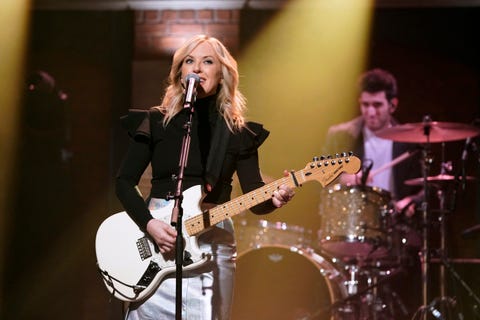There was a part of Liz Phair that thought she’d never make solo music again. “If that younger generation hadn’t come forward with all those female artists, I very much doubt I’d put out a new record or tour,” the platinum-blonde singer says over Zoom from her home in Los Angeles. Phair, now 54, is referring to artists like Soccer Mommy, Snail Mail, Haim, and Phoebe Bridgers, all of whom have asserted their autonomy within a mysoginist industry. There’s now a space for vulnerable songwriting, and the once-taboo topics Phair was criticized for bluntly singing about—sex and the power dynamics of a male-dominated world—are the norm. She couldn’t be more thrilled.
For the past few years, Phair’s has been inching toward a comeback. In 2018, there was the re-release of her landmark debut Exile in Guyville for its 25th anniversary, along with her bedroom tapes, which she recorded under the moniker Girly-Sound. There was a tour in 2018 to coincide with it, and she’d been working on a record (since scrapped) with now-disgraced singer-songwriter Ryan Adams. In 2019, Phair released her debut memoir Horror Stories, an introspective look at the moments that have haunted her throughout her life. That same year, she shared her first single in 10 years, “Good Side,” with the assumption that Soberish would soon follow. But the pandemic hit and life went on pause. “I didn’t realize I was putting something out that would hang in the air for a year,” she explains. “I thought we were going to follow right up with the next one, the next one, the next one. There was a dance that we were about to perform for you that didn’t happen.”
Now, finally, Phair is ready to share her seventh studio album, a sonic palette filled with pop hooks, frank storytelling, and familiar guitar riffs representative of her storied career. “I knew I wanted to have our old sounds, so that there was a resonance between our early work together and this one,” she says of working with producer Brad Wood. Still, Phair is “pushing the boundary futurewise,” with sticky choruses and rule-breaking arrangements, while paying homage to the guitar and drum sounds of Guyville.
Below, Phair speaks to ELLE.com about her creative process, playing psychologist to people angry about her 2003 self-titled LP, and being “soberish.”
It’s been 10 years since you released a record. Why now?
It’s funny, I think it’s actually been longer than that. Even though Funstyle was a record, I never intended that to be considered an actual “Liz Phair record,” per se. That’s why I called it “Funstyle.” It was what we were doing on the side while I was scoring television, so [Soberish] is my first attempt at an actual album in 16 years. Lots has happened since then. My son went to college, and I started to go back to my music career thinking, “Yeah, I’ll tour now.” I meant to make a record, as some people know now, with Ryan Adams. That was an on-off process for a couple of years that kept starting and stopping. That was kind of demoralizing, and it took until we worked on the reissue [of Exile in Guyville] with [Matador Records] that I connected again to that part of my career. Because Brad and I were in touch, it felt so easy to slide right into working with him again. It just was a slow process, and then boom, 2020 hits right as we’re about to release, and we get another delay. Though it has been slow, it has been deliberate for at least the last five years—trying to get back into making an album proper.
What made it so challenging for you to actually make a record again?
I’m a very big-picture person, so if I ever have writer’s block, it’s about not seeing the vision for the end product. I knew I wanted this to have our old sounds, so that there was a resonance between our early work together and this. The way Guyville sounded fresh and new to people then, I wanted this to be pushing the boundary future-wise a little bit. I was aiming for something that would be us with the guitar and drum sounds of Guyville, but positioning us as maverick-feeling—the way it felt back then, like we were breaking some rules and pushing the edge. That was a hard ask after 20 years of practically not working together. How do we sound like our old selves, but sound like we’re leaning forward into a place that people have to move toward?
What is the meaning behind the term “soberish” and why did it become the album title?
Well, I wrote the song first. Sometimes I look for an album title within the titles of the tracks and “Soberish” became ever more important to me. I’ve always been into smoking pot—that was always my favorite escape of choice. I lived my life mostly sober, and then I’d go out and party, and I’d feel no qualms whatsoever about doing whatever drugs were on offer. Slowly, when they legalized pot, that became a second puberty for me, and I was like, “I can’t handle this.” I needed the roadblock, and it became this thing of, “How do I want to live my life?” I decided that “soberish” was a really good line to draw: You’re not wasted, you’re not totally straight, you’re just “soberish,” and that can be anything.
I’ve decided to envision this as a street sign [on the album art], so that there’s “Sober Avenue” and “Ish” Street. When I go from being sober to “it’s time to party,” I step back into a second self that I’m very familiar with, like, “I’m back!” and it feels like I’ve just turned a corner. My happiest life is lived on that street corner where I can toggle back and forth between sober and that other self—that’s my party self. We don’t have good words for this in this culture because it’s always been deemed a sin, but to me, it’s not a sin at all. It’s ridiculous to think of it that way. [It’s about] identifying that crossroads between one side of yourself and another, and trying to hold that position, because I think that’s a pretty kick-ass position to be in.
How did you approach shaping the sound of the album?
The first thing I came in with was, “Have you heard ‘Old Town Road’?” It had just broken, and I was like, “Brad, that is the biggest song in the entire nation, and it’s two minutes. It’s like a mash-up between I don’t even know what styles, and we are going to do something [where] none of the songs are going to be the same. They’re all going to be catchy and yet no one’s going to notice how much shit we’ve [played] with behind the scenes.” I’ve stuck bridges in second verses all over this record. I’ve added whole second songs to the back end of shortened front songs. There’s a lot of sound design, and there’s a lot of playing with spatial sounds. And then there’s Brad with his incredible ability to make stuff gorgeous. I can throw a shitty little hook that I played out of time to him, and he can slap some plugins on it. We’re like crazy, mad scientists in there, and we both agree when it’s right.
In 2019 you released your first new single in 10 years, “Good Side.” Why was that the perfect reintroduction for you?
Honestly, I don’t know if it was a perfect introduction. It was infectious, and the lyrics weren’t super heavy. I thought of it as a, “Hi, hello there, we’re about to lay out a whole series of things for you.” It felt positive with a little snark, and some accessibility to it. It just felt like a good door to welcome people to Soberish. It also had a cool structure, and I said from the beginning that none of these songs are going to be traditionally structured and we’ll be playing with all sorts of rule-breaking of the canon.
A few years ago you played shows with Soccer Mommy and Snail Mail. How have you been inspired by this generation of unflinchingly honest indie rock singer-songwriters?
These young female artists are so, to my eyes, free right now: to be, and to be autonomous and to be respected and be taken seriously. That is so different from when I was their age, so I take enormous pleasure, inspiration, and joy. The fact that women came forward—I guess, because of the technology, they could do their own recordings—the gatekeepers fell away. That is the wind beneath my wings. It’s so embarrassing to say, but it kind of is. That’s a world I want to live in, that’s a game I want to play in, and that’s a field I want to be on. It’s so important to me that they’re doing what they’re doing, and it’s why I’m back.
I know Funstyle wasn’t exactly a record, but technically that was your last album, and it got pretty mixed reviews. How do you look back on it now?
I look back on it exactly the same way I felt when I put it out. I thought it was quite obvious that this was supposed to be a “fun thing.” I’ve got so many songs that just sit in the closet that didn’t make an album cut, and we were doing these things that cracked us up.
I think you’re being very kind to say that it was mixed reviews. I misperceive how people look at me a lot of the time. I misperceive how people look at music output, what fans invest in musical output, and I see it from my point of view as a creative output-er. I think I lost my management over it. They were like, “We can’t promote this.” I wish you had more freedom as an artist to try things and experiment and not give the same weight to each one. But there’s a way that the music business works where to get people to promote, it’s like a political campaign. People are asking favors of other people to get certain things done, and there’s a whole choreography to this. There’s too much capitalism in our art, I think.
In a way that reminds me of your pop-leaning self-titled record, which has some great songs, but at the time of its release was perceived as you “selling out.”
I was a young mom, and I think I took it as like, “How can I help these people?” All the phone [interviews] I was doing [were] therapy with people who were angry at me personally for putting that record out. I would just get 10 in a row and I was trying to help them through their anger at me. There were some things that hurt, but for the most part, I was busy.
As people know now, Matador connected with Capitol Records; I didn’t choose to be on Capitol. And then when they left, I was retained, and that was not my choice, and I was the only artist left behind on Capitol Records, and they happened to be going into a big pop phase. I got the very distinct sense that if I didn’t play ball, I wasn’t going to play at all. I figured out a way to navigate that in a way that I’m fine with. Like, “Favorite” is a little embarrassing, and it was at the time. I remember arguing with Lauren [Christy], “I can’t sing that,” and she’s the co-writer. She’s like, “Yes you can, it’s a hit.” The experience of my career from my point of view, compared to the fans’ point of view, is very, very different. I had fun making pop records, and I still love singing those big pop songs live. That record to me looks very different than it does to the fans, and it sucked to be vilified. It definitely weighed me down, but I didn’t take it, even then, as personally as people probably thought I ought to.
It sucks that you had to do the emotional labor of being people’s therapists in interviews.
I did. Over and over again. I had to keep reminding people it was just music. You don’t have to buy it. This isn’t going to impact your life, or it doesn’t have to. To some extent, I care only because I hate to see people upset. I would prefer that music be music. You should enjoy all of it if you like it.
When you were promoting your book Horror Stories in 2019, you said you were already working on another memoir. What’s the status of that?
It’s Fairy Tales, and it’s the second part of Horror Stories. It was always designed as a two-parter memoir, and I saw it as sort of the yin and yang symbol: Horror Stories would be these sexual, unconscious, darker, stories. The regret, but with this bright, clearly defined center of beauty, hope, life, and truth. Then Fairy Tales will be the glamorous stories, my rock stardom, and fantastic trips I’ve taken, with this hard, dark sense of something upsetting, disturbing or corrosive at the center of it. A horror story is a fairy tale depending on where you start it and how you tell it. And a fairy tale is a horror story depending on how you tell it. Life is mutable that way. I’m playing with a soundboard but with writing, and that’s the game for me.
This content is created and maintained by a third party, and imported onto this page to help users provide their email addresses. You may be able to find more information about this and similar content at piano.io


